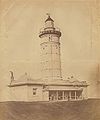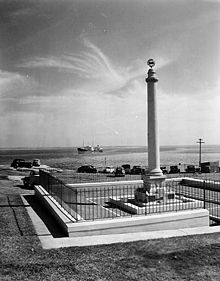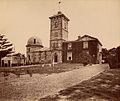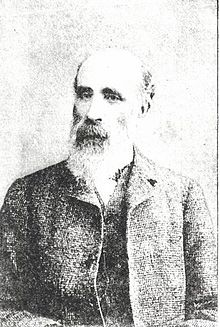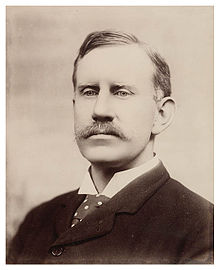- New South Wales Government Architect
-
The New South Wales Government Architect is an officer of the New South Wales government. Historically, the government architect was in charge of the state government's public building projects.
Today, the Government Architect continues to serve this role as the General Manager of the Government Architect's Office (GAO), which is a multi-disciplinary consultancy operating on commercial principles providing architecture, design, and engineering services. Since the 1990s, when the consultancy service began operating on commercial principles, the Government Architect has reported separately in a second capacity, as an advisor to the government, and serves on various committees and boards in relation to heritage protection, architecture, and design.
The first Government Architect was Francis Greenway, appointed in 1816. The current, 22nd Government Architect, is Peter Mould.
Francis Greenway 1816-1822
The first official architect for the colony of New South Wales in a role that would become the New South Wales Government Architect was Francis Greenway. He was appointed in 1816 by Governor Macquarie to be Acting Civil Architect and Assistant Engineer responsible to Captain J M Gill, Inspector of Public Works. Greenway was a convict who had been sentenced to transportation for forgery. Greenway's works included the Macquarie Lighthouse on South Head, the Fort on Bennelong Point and the Stables for Government House. Greenway's other major buildings include the Obelisk in Macquarie Place, the Church of St James, St Mathews Church at Windsor and the Hyde Park Barracks.
-
Hyde Park Barracks, designed by Francis Greenway; Old Colonial Georgian style; drawing by William Hardy Wilson in 1914
-
The first Macquarie Lighthouse, built 1816-18 photograph taken in the 1870s; from the 'Papers of James Barnet'
-
Lithograph of St James Church c. 1836 by Robert Russell
Colonial Architects 1822 - 1835 under Governors Brisbane, Darling and Bourke
Leaders of the free settler community in New South Wales, such as Wentworth and Macarthur, complained to London about Macquarie's policies, and in 1819 the government appointed an English judge, John Bigge, to visit New South Wales and report on its administration. Bigge generally agreed with the settlers' criticisms, and elements of his reports criticised Governor Macquarie’s administration including his excessive spending on public works. Bigge's reports on the colony led to Macquarie's resignation in 1821.
When Macquarie returned to England in February 1822, Greenway was without his patron and on 15 November 1822, the recently appointed Governor Brisbane dismissed him from the office of Civil Architect.
Brisbane's two replacement appointees lasted only short terms. Governor Darling arrived in December 1825 and dismissed the incumbent architect, George Cookney, a few months later. Darling left the position of Civil Architect vacant for the term of his governorship while he continued the process of reviewing the structure and roles of the Departments that made up the Public Service.
Governor Bourke succeeded Darling in 1831. Bourke initiated a major enquiry into the Department of Public Works and suspended its Director, Charles Wilson. Bourke had received numerous allegations anonymously against Wilson and the Department. Wilson was dismissed and following him, six of the next top officers were also dismissed. In effect, the Department of Public Works ceased to function on the date of those dismissals, 13 March 1832.
Bourke established the Colonial Architect's Department in 1832 to be responsible for the planning and supervision of the construction and repair of public buildings. In general, the Colonial Architect's Department had charge of public buildings and their furniture, the duty of preparing plans and specifications for construction and repair and superintending all works executed by contract. From 1833 - 1835 the Department briefly became the Architectural Branch of the Department of the Surveyor General before the Colonial Architect's Department was again separately established.
Standish Lawrence Harris 1822 - 1824
To replace Greenway, Brisbane appointed Standish Lawrence Harris, a recently arrived free settler as Civil Architect in late 1822. Harris' main achievement seems to be in preparing a report on the condition of the Colony's public buildings requested by the Governor. Harris criticised his predecessor's works. Governor Brisbane found Harris's fees to be excessive. The Civil Architect reported to the Chief Engineer, Major John Ovens. Ovens had stated that Harris' services "can no longer be useful to me" and Harris was dismissed in October 1824.
Other than his report on the colony's public buildings, Harris's possible contribution was the completion of the new Courthouse at Sydney begun by Greenway. Harris made enlargements and prepared drawings and specifications, but there is some doubt as to whether even his design was that ultimately adopted. Harris made recommendations about the organisation of the Office for Public Works and the role of the Civil Architect, which were adopted.
George Cookney 1825 - 1826
George Cookney was an English architect, the son of D'arcy Wentworth's London agent. Cookney was sponsored by Wentworth and his son William Charles Wentworth. Governor Brisbane appointed him in April 1825, however, there were not a lot of projects he was asked to look at.
The only major work completed by Cookney was a memorial at the Sydney suburb of La Perouse to Jean-François de la Pérouse, the French explorer who visited Botany Bay in 1788. The memorial was requested by Baron de Bougainville, the son of the more famous French explorer, Louis Antoine de Bougainville, who visited Sydney in 1825. At de Bougainville's request, Governor Brisbane directed Cookney to design both the monument and a tomb to be erected over the grave of one of La Pérouse's crew who had been buried at Botany Bay.
Ambrose Hallen 1832 - 1834
From 1827 Ambrose Hallen had been the Town Surveyor within the Public Works Department. Within the Department of Public Works, Hallen took on the role of Architect and Town Surveyor under Charles Wilson, the Director of Public Works; under Wilson's directorship, Hallen having become increasingly engaged in minor architectural matters.
When Governor Burke succeeded Governor Darling in December 1831, he initiated an enquiry in to the Department of Public Works. Wilson and six of those who were immediately under him were dismissed in 1832. Hallen was the next most senior officer and was placed in charge of what remained of the Department on 1 April 1832; later that month he was given the title of Colonial Architect and his office was officially titled the Colonial Architects Department. The position as Town Surveyor was absorbed into the Surveyor General's Department (the role was filled by Mortimer Lewis who was later to succeed Hallen as Colonial Architect). In creating the Colonial Architect's role and Department, Governor Bourke defied directions from the Colonial Office in Whitehall, London, which had specified there was to be no such office as an entity separate from that of the Surveyor General.
The new department only had 10 officers and was operating under tighter management following the review of the Department of Public Works. Hallen was not found to providing the necessary leadership and the office became part of the Surveyor-General's office under Thomas Mitchell.
Buildings include St Brigid's school at Millers Point.
Hallen designed the gaol at Berrima. It was based on the radiating system of inspection. He also designed a courthouse at Berrima. However, the cost of building would have significantly exceeded the funds allocated. Hallen resigned at the end of 1834.
Mortimer Lewis 1835 - 1849
Mortimer Lewis was appointed by Governor Bourke whose term was completed in 1837. He served also under Governor Sir George Gipps (1838–1846) and Governor Sir Charles Augustus FitzRoy (1846–1855).
In the mid 1830s there was seen to be an increasing need for new buildings relating to policing, including gaols, courthouses and lock-ups. Bourke negotiated with the Colonial Office in London that these buildings should be built by the Colonial Architect from the Colony's own resources and that this would give greater respect for the buildings, stating: "The attention of the Colonists will be called to them, an interest acquired in their preservation, which does not seem to attach to those works, which are defrayed at the cost of the British Treasury alone."
At the same time, responsibility for civil and military buildings was made separate. Accordingly, these roles reported direct to the governor. The Surveyor-General, Thomas Mitchell, would have supported the independence of Mortimer Lewis, who he had worked with while Lewis was Town Surveyor, and whom Mitchell had suggested would fill the role better than Hallen had. Mortimer Lewis was appointed Colonial Architect in April 1835. Final approval for the arrangements only came in September 1837, due to the delays in corresponding between New South Wales and England by ship.
One of Lewis's earliest works was the court house at Darlinghurst. It was significant as a building as it was deliberately built in the popular Greek style fashionable in England to convey a sense of the importance of purpose of the court house. He also managed the project in a more politically astute way by getting the government to approve sequential work rather than a single large intimidating budget.
Lewis produced courthouses at Goulburn, Bathurst, Berrima, and Hartley, and gaols at Berrima, Maitland, Bathurst and Goulburn. Most of these buildings were later replaced.
Under Lewis, the Colonial Architect's Department of Victoria was established at what was at first the new settlement at Port Phillip. The beginnings of the Colonial Architect's Department of Queensland also occurred under Lewis.
In 1843 there was a significant change in the governance of the colony of New South Wales as the first partially representative Legislative Council was established. The new Council was concerned to minimise expenditure and the appropriation of funds for public works was reduced with a consequent reduction of quality and output of the Colonial Architect's Department.
In 1844 the duties of the Colonial Architect were expanded to cover the role previously performed by the Colonial Engineer, that is superintendence of roads, bridges, wharves and quays. From October 1848 military buildings and works were also placed under the charge of the Colonial Architect.
Lewis resigned in 1849. Major works that Lewis mentioned in his resignation statement were six gaols, eleven Courthouses, the new Government House, the Tarban Creek Lunatic Asylum, later known as the Gladesville Mental Hospital, Customs House, the new Treasury building, the Post Office and numerous other buildings. He also included civic works at Circular Quay and at Newcastle.
His resignation resulted from an enquiry into the building of the Australian Museum. Lewis was the fourth of the five government architects to be dismissed. If Hallen had not resigned, it was quite probable he would have been dismissed also.
-
Court house at Berrima; completed 1838
Edmund Thomas Blacket 1849 - 1854
Main article: Edmund Thomas BlacketEdmund Thomas Blacket was appointed by Governor Sir Charles Augustus FitzRoy (1846–1855).
William Weaver 1854 - 1856
William Weaver was appointed by Governor Sir William Denison (1855–1861).
Alexander Dawson 1856 - 1862
Alexander Dawson served under Governor Sir William Denison (1855–1861) and Governor Young (1861–1867).
From 1856 the Colonial Architect's Department reported to the Secretary of Lands and Public Works and from 1860, with the separation of Public Works from Lands, under the Secretary for Public Works.
Alexander Dawson constructed at least two lighthouses, Point Stephens Light and the Hornby Lighthouse.[1]
-
Albury Court House
-
The Observatory, The Rocks, Sydney, photographed 1874
James Barnet 1862 - 1890
- see main article James Barnet
James Barnet was appointed by Governor Young (1861–1867). He served under Somerset Lowry-Corry, 4th Earl Belmore (1868–1872), Sir Hercules Robinson (1872–1879), Lord Augustus Loftus (1879–1885), and Charles Wynn-Carington, 3rd Baron Carrington(1885–1890).
During Barnet's career, the Colonial Architect's office produced over 1,350 works. He listed on his retirement 169 Post and Telegraph offices, 130 Courthouses, 155 Police Stations, 110 lock ups and 20 lighthouses. During his time as Government Architect there were 20 separate Parliaments, 16 Ministers and nine different Premiers. He made more visible imact on the colony than any other public servant of his time.
-
Chief Secretary's Building, Constructed 1873-1880
-
Yass court house; 1880
-
The court house at Goulburn; Italianate style; opened 1887
Walter Liberty Vernon 1890 - 1911
Main article: Walter Liberty VernonWalter Liberty Vernon was born in 1846 at High Wycombe in England, educated at Westminster, and had a successful London practice before leaving for Australia in 1883 for medical reasons.
Vernon worked in private practice in Sydney before joining the newly named Government Architect’s Branch in 1890 as Branch Head. Funds and staff were depleted for the first years of Vernon’s term, until 1894, in response to the depression, the Government voted 136,635 pounds for the new building works.
Under Vernon's directorship the Arts and Craft style came to be used increasingly for public buildings. Notable examples include the Fire Stations at Darlinghurst and Pyrmont, as well as Post Offices and country Courthouses. Using the Arts and Crafts style meant these buildings were less monumental than those built by Barnet. However, Vernon also built a number of major public buildings, such as the Mitchell wing at the State Library, the Art Gallery of New South Wales, Fisher Library at the University of Sydney and Central railway station, Sydney. These buildings maintained the classical tradition. Vernon also added to a number of the buildings designed by his predecessors including Customs House, the GPO and the Chief Secretaries building.
The office under Vernon was responsible for the design and installation of the elaborate decorations and illuminations in the city to celebrate the Federation of the Australian colonies in 1900.
Vernon retired from the position of Government Architect on 11 August 1911.
-
Braidwood court house; 1890
-
Wagga Wagga court house; built 1901-1903
-
Temora court house; 1902
-
Art Gallery of New South Wales; built 1904-1909
George McRae 1911 - 1923
Main article: George McRaeGeorge McRae was born in Edinburgh in 1858. He arrived in Sydney in 1884 and was appointed Assistant Architect in the City Architect’s office. He became City Architect and City Building Surveyor in 1889, a position he held until 1897 when he was appointed Principal Assistant Architect to Vernon in the Government Architect's Branch. He succeeded Vernon as Government Architect in 1911 and held the office until his death in 1923.
Works undertaken by McRae during his term as Government Architect include: the Education Dept Building, Bridge Street (1912); Parcels Post Office, Railway Square (1913); Taronga Zoo lower entrance, top entrance, and Indian elephant house; Corporation Building, Hay Street, which is on the Register of the National Estate; additions to the Colonial Treasury Building in Bridge Street; Queen Victoria Building, George Street, also on the Register of the National Estate; and Cessnock Court House.
From 1912 until 1937 the Government Architect's Branch was housed in the “Tin Shed”, a temporary building on the site of the first Government House and demolished in 1970.
Gorrie McLeish Blair 1923 - 1926
Gorrie McLeish Blair was born in 1862 in Scotland. He entered the Government Architect's Branch in 1895 as an architectural draughtsman. By 1912 he had become First Class Assistant Architect in charge of the drawing office, and by 1916 Principal Designing Architect.
Blair was appointed Acting Government Architect on McRae's death in 1923 and promoted to Government Architect in 1926. Blair was responsible for the design of several war memorials, additions to Katoomba Court House and Wards 24 and 25 at Callan Park.
Richard McDonald Seymour Wells 1927 - 1929
Richard McDonald Seymour Wells was born in Australia in 1865, and his promotion to Government Architect in 1927 made him the first Australian born architect to hold that post.
Wells first joined William Kemp's office in the Department of Public Instruction in 1881, working on the design of schools. He transferred between the Department of Public Instruction and the Government Architect’s Branch for a number of years as the responsibility for school design changed between departments.
Wells designed the conversion of the Old Stables to the new Sydney Conservatorium of Music in 1913, as directed by the Minister for Public Instruction. During Wells' term as Government architect, he supervised work on the Dixson Wing of the State Library of New South Wales, The Travers Building at Sydney Hospital, the Nurses’ Home at Maitland Hospital and many additions to public schools.
Wells retired as Government Architect in 1929.
Edwin Smith 1929 - 1935
Edwin Smith was born in 1870 in Scotland. He arrived in Australia in 1889, and worked as a draughtsman in the Queensland Department of Public Works and as Chief Architect in the Victorian Department of Public Works before being appointed Government Architect of New South Wales in 1929.
Smith reorganised the Government Architect’s Branch in 1930 to absorb the Architect’s Branch of the Department of Public Construction. During the 1930s depression, Smith initiated documentation for public buildings erected under the Unemployment Relief Council.
Works undertaken during Smith’s term of office include: University of Sydney Blackburn Building, Tea Gardens Court House, Quirindi Courthouse, Lismore District Works Office, and Lismore Police Station.
Smith retired in 1935 and died in 1965, aged 95 years.
Cobden Parkes 1935 - 1958
The youngest son of Sir Henry Parkes, Cobden Parkes had been employed in the Government Architect's Branch on the re-introduction of the cadet system in 1909. He enlisted in 1914 and, following a convalescence after the war, re-entered the office in 1920.
Cobden Parkes was the first Government Architect to be fully trained within the office. Prior to World War II, Parkes fostered design changes in hospitals which continued in the expanded building program of the war years. Defence construction, including bomb shelters for public buildings was also a feature of this period.
In the decade of post-war recovery, the office used prefabricated aluminium buildings imported from Great Britain in the building of schools and hospitals. The range of public buildings broadened from the 1950s, with financial provision for a substantial increase in construction of educational institutions – universities and technological institutes and residential colleges – and in recreational and welfare buildings and markets.
Parkes retired in 1958, almost 50 years after his appointment to the Government Architect's Branch.
Edward Herbert (Ted) Farmer 1958 - 1973
Ted Farmer was born in 1909, educated at the University of Melbourne, joined the NSW Government Architect's Office in 1939, and was appointed Government Architect in 1958.
Under his leadership the work of the Government Architect's Office flourished, winning four Sulman Medals, two Blacket awards and one RIBA Bronze Medal. Farmer himself was awarded the RAIA Gold Medal in 1972.
Notable buildings from Farmer's 16 years as Government Architect, with Harry Rembert as Chief Design Architect, were St. Margaret’s Hospital Chapel and nurses’ home, the Chemistry School and new Fisher Library at the University of Sydney, the residential colleges at the University of NSW and the University of New England, Belmont Primary School, Heathcote High School, Taree Technical College, and the Mona Vale Hospital. This was also the period in which the Sydney Opera House was completed.
Under Farmer, restoration and heritage planning achieved prominence as a function of the Government Architect's Branch.
Peter Webber 1973 - 1974
When Geoffrey (Peter) Webber became Government Architect, the Department was rearranged in to six specialist sections; Schools, Health Buildings, Tertiary Education, Public Buildings, Special Projects and Services. The Special Projects section at this time was undertaking work at Taronga Park Zoo, Parliament House, Ryde Food School, the Art Gallery and Library of NSW.
The Special Projects Section included a Historic Buildings Group and a Landscape Group. At this time the Government Architect’s Office was one of the largest architectural offices in Australia with a staff of 800 spread between Head Office and six District Offices throughout the state.
Peter Webber left the Government Architect’s Branch in 1974 to take up a position as full-time Commissioner in the New South Wales Planning and Environment Commission.
Charles Weatherburn 1974 - 1978
Charles Weatherburn’s career with the Government Architects Branch spanned almost 40 years. He joined the Department of Public Works in 1938 as an architect and up until the outbreak of World War 2 was involved in hospital design. Four years in the army was followed by service in Narrabi, 3 years as District Architect in Cootamundra, 8 years as Architect-in-Charge of the drawing office, Research Architect, executive assistant to the Government Architect, Assistant Government Architect, and finally Government Architect in 1974.
Charles Weatherburn had a close involvement with the Opera House, and contributed to the successful completion of the project.
Other major projects he was associated with include the Institute of Technology, Goodsell Building, Mckell Building at Rawson Place, Parliament House, Westmead Hospital and an ever increasing and highly sophisticated schools and building program.
Ian Thomson 1978 - 1988
In the late 1980s the Government Architect's Branch became the Architectural Division of the Department of Public Works.
John Whyte (Ian) Thomson was born in Lancashire in 1928. He moved to Sydney in 1960 and joined the Government Architects Branch of the Public Works Department in the same year.
From 1960 to 1965 he assisted in the design and documentation of the Fisher Library at the University of Sydney. In 1978 when Ian Thomson became Government Architect, he ushered in a period of unparalleled growth and building activity, which culminated in the completion of many projects for the 1988 Bicentennial Celebrations.
Work completed during this period includes: The Powerhouse Museum, Ballina Police Station, new Parliament House Sydney, the Western Plains Zoo, the Gardens Restaurant in the Royal Botanic Gardens, the Federation Pavilion at Centennial Park, the redesign of the foreshore areas at Circular Quay, the Macquarie Street upgrade, and a wide variety of conservation and heritage work.
In 1987 the Government Architects Branch, first named in 1890, was renamed the Architectural Division of the Public Works Department.
Ian Thomson retired as a Government Architect in 1988.
Lindsay Kelly 1988 - 1995
On 1st July 1988, Lindsay Kelly became the 20th Government Architect for New South Wales. Unlike many of the 19th century Civil and Colonial Architects, Linday Kelly brought to the position of Government Architect formal architectural qualifications of the highest order: - a first class honours degree in Architecture, a Master of Architecture and a Master of City Planning, as well as the 1984 Sulman Prize for the design of Parklea Prison.
On 15th November 1991, the Minister for Public Works announced that Public Works had been entrusted with a new Government Services Charter. Under this Charter, new responsibilities were given to Division Heads, and the title of Government Architect was changed to “Director of Client Services and Government Architect” to reflect the new responsibilities.
Considering the tasks ahead. Linday has commented: “While responding to the commercial aims of Government my office will continue to provide a strong cultural dimension in Architecture.”
Chris Johnson 1995 - 2005
Chris Johnson oversaw the transformation of the office from a bureaucracy to an office run on a fully commercial basis.
During his term as Government Architect, Johnson strengthened the profile of the role in the public perception. During the Olympic Games in Sydney in 2000 he established a design review panel and a design directorate to oversee the design and procurement of the public domain for Sydney Olympic Park and other significant projects.
A range of important projects were designed in the office, most noticeably the Conservatorium of Music (2002), the upgrade of Circular Quay (2002) and the upgrading of George Street and Railway Square (2000).
Another major achievement was the "Houses of the Future Exhibition" during the Year of the Built Environment (2004). Johnson retired as Government Architect in July 2005.
Peter Mould 2005 - Present
Following Johnson's retirement, Peter Mould acted as Government Architect and was appointed as the NSW Government Architect and General Manager of the Government Architect’s Office on 15 February 2006.
Peter Mould has extensive experience in both the private and government sector and is well placed to work with government, industry and the design profession.
Peter is the 22nd Government Architect in NSW.
See also
References
- ^ Rowlett, Russ. "Lighthouses of Australia: New South Wales". The Lighthouse Directory. University of North Carolina at Chapel Hill. http://www.unc.edu/~rowlett/lighthouse/nsw.htm. Retrieved 2010-08-29.
- "Francis Greenway to Mortimer Lewis 1816 - 1849". History. New South Wales Government Architect. 2005. http://www.govarch.dpws.nsw.gov.au/history/greenway_lewis.htm. Retrieved 2006-01-24.
- "Edmund Thomas Blacket to James Barnet 1849 - 1890". History. New South Wales Government Architect. 2005. http://www.govarch.dpws.nsw.gov.au/history/blacket_barnet.htm. Retrieved 2006-02-06.
- "Walter Liberty Vernon to Cobden Parkes 1890 - 1958". History. New South Wales Government Architect. 2005. http://www.govarch.dpws.nsw.gov.au/history/vernon_parkes.htm. Retrieved 2006-02-06.
- "Ted Farmer to Chris Johnson 1958 - 2005". History. New South Wales Government Architect. 2005. http://www.govarch.dpws.nsw.gov.au/history/farmer_johnson.htm. Retrieved 2006-02-06.
- "Government Architect". Concise Guide to the State Archives. State Records of NSW. 2004. http://www.records.nsw.gov.au/cguide/c4g/govarch.htm. Retrieved 2006-01-26.[dead link]
Categories:- New South Wales architects
- Australian architects
- Australian public servants
-
Wikimedia Foundation. 2010.


